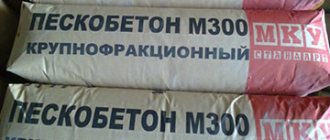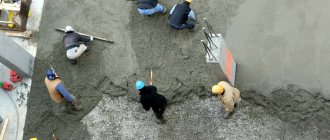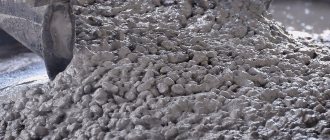Concrete is the main building material that is used throughout private and industrial construction. Reliable and durable material is made from a mixture of sand and cement (quite often gravel or crushed stone is also added to it). Depending on the technology for preparing the solution and the ratio of its components, the physical and chemical properties of concrete will also change. Most often, the M300 DSP is used for mixing it.
Application of sand concrete
Branded cement mixture is selected for concreting coatings with a load of about 250-300 kg/cm².
According to this indicator, M300 is suitable for installing a high-strength, wear-resistant floor in a basement, utility room, technical or residential area. CPS depending on the sand fraction:
There are no restrictions on the thickness of the applied layer if structural reinforcement is used.
Component proportions and DSP consumption
The standard cement composition includes 1 part of Portland cement of the brands PTs400 D0, PTs500 D20 and 2 times more dried sand of standardized fractions. Polymer and mineral additives may be included to improve certain characteristics:
- plastic;
- frost resistance;
- moisture resistance;
- thermal conductivity;
- resistance to abrasive influences.
Fiber and microsilica may be added by the manufacturer.
In terms of efficiency, the consumption of such a mixture per 1 m2 is quite low. As the size of the M300 layer increases, the costs of sand concrete increase:
- for 1 mm of solution application thickness, about 1.7 kg/m2 is used;
- at 2 mm there is an increase to 3.5 kg for the same area;
- for a 10 mm screed you need 22 kg of dry compound per 1 m2.
The exact consumption of M-300 must be looked at on the packaging, since it differs from different manufacturers and can range from 18 to 30 kg/m2. For pouring screeds, higher values are calculated, since its thickness is standardized by SNiPs from 50 mm.
Independent preparation of sand concrete
The proportions of cement and filler depend on the type of structure being constructed:
Price for DSP
Among industrially manufactured DSPs, the following brands are distinguished by their popularity (and low cost):
- Stone Flower;
- Roussean.
The guaranteed high quality of Rusean is also evident in the fact that the declared strength (30.4 MPa) is higher than the standard for the M300 line (30 MPa).
Preparation
When making a solution, it is necessary to take into account the proportions of the components used.
You also need to take into account the type of structure being built:
- For the screed you will need 1 part of Portland cement of a grade not lower than M400 and 3 parts of sand. To make the base more durable, it is recommended to add fiberglass or reinforcement to the mixture.
- To prepare a solution for plastering, the proportion will be 3:2 (sand, cement). It is worth considering that such a solution must be developed as quickly as possible. Otherwise it will dry out quickly.
Some novice builders believe that to prepare the solution themselves, it is enough to mix all the components with water. In fact, first of all it is necessary to combine sand with cement and mix them thoroughly until a homogeneous dry mass is obtained. Only after this can water be added to the solution. At the next stage, it is better to use a concrete mixer and mix everything thoroughly again.
If the solution is made in the wrong sequence, the finished building will have low strength characteristics and will collapse quite quickly. Therefore, it is better to make batches using specialized equipment.
Composition of sand concrete
The universal composition of sand concrete M300 gives the material strength and optimal performance properties. The number of different components from different manufacturers may differ slightly, but the basic components are as follows:
In addition to the main components, the composition may contain granite screenings or chips, necessary additives or plasticizers.
Thus, additives that resist low temperatures, strengthening fibers and other components are used in the dry mixture, depending on the scope of use of the material and its manufacturer.
All kinds of chemicals are added to make it possible to increase the functional and technological properties of sand concrete.
Kawabanga! Foam concrete; characteristics, advantages and disadvantages of building materials
Sand grain size for the mixture
When preparing a dry screed or other concrete structures, an indicator such as the sand fraction is taken into account. Depending on the size of the granules of this material, CPS can be used for certain purposes:
- Less than 2 mm – fine sand. Such raw materials are used in the preparation of mixtures for sealing cracks, seams and chips in concrete foundations.
- From 2 to 2.2 mm – medium-fraction sand. This material is suitable for arranging screeds, laying paving slabs, curbs and much more.
- More than 2.2 mm – coarse sand. Such raw materials are suitable for the construction of more serious structures (foundations and other foundations).
Calculation of sand concrete costs
The characteristics of this material allow it to be used in creating wear-resistant surfaces, leveling them and when laying stone, brick and tiles. In addition, it is used as a composition with fine grains for concreting.
The main conditions for this are high-quality preparation of the surface: it is necessary to clean it well, level it and then prime it, and treat it with agents that resist the development of fungus.
Also, different manufacturers may recommend the use of concentrated additives intended for specific purposes: from strengthening compounds to antibacterial agents.
For 1 m3 of concreting, 25-30 bags of dry mixture without adding filler will be required.
When using fillers (it is permissible to add fine gravel, fine crushed stone, sand to the solution), the properties of the finished concrete change and the consumption of the dry mixture becomes less.
Dry mixture x 6cm = 120kg, material costs for the entire area of the room will be 7200 kg, 150 bags of sand concrete m 300.
Brand of cement for the foundation and its ratio with sand and crushed stone
The foundation is the most important part of any structure, and the stability, durability and safety of the house will depend on its strength. In this regard, when constructing the foundation, it is necessary to use correctly selected cement. The brand of the latter depends on the load that the foundation part will experience in the future. The grade of concrete means the compressive strength of the hardened composition. The higher the number, the higher the strength, but the higher the price. But when building a foundation, it is contraindicated to skimp on quality.
In the case of concrete preparation, you can use cement grade 100. However, for the construction of the foundation we will use options from M300 and higher. If you want to achieve maximum structural strength, then take the M500, since its price is not much different from the M400. As for the ratio, it is usually 1-3-5 based on cement, sand and crushed stone.
Instructions for using sand concrete M300
The next step is to mix the solution and pour it ready onto the surface to be treated. Before processing, it is advisable to slightly moisten the surface on which our sand concrete will be poured.
M300 has plenty of advantages, the only caveat is that the solution can only be used if the ambient temperature is not lower than 60.
Material composition
The components included in the dry mixture may differ from one manufacturer to another, but the standard components are as follows:
Various additions are often added to the dry mixture: regulators, softeners. Technical assessment and area of use directly depend on the amount of additives in the solution. The ratio of components in concrete m200:
- cement 1 part;
- sand 2.8 parts;
- crushed stone 4.8;
- water makes up 20% of the total mass.
Replacing crushed stone with gravel allows you to increase the density of the solution.
Areas of use
Some nuances of the cost of sand concrete M300
| Brand of mixture | Bag weight, kg | Price for 1 bag, rubles | Price per ton, rubles |
| Stone flower M300 | 40 | 120 | 3000 |
| 50 | 145 | 2900 | |
| Sand concrete Rusean M300 | 40 | 145 | 3620 |
| LUIX M300 Roussean | 40 | 130 | 3250 |
| Standard M300 | 40 | 110 | 2750 |
The prices given are relevant for the central regions of the country and do not include the cost of delivery, which in an unfavorable situation can increase costs by 25 - 50%.
Characteristics
| Water consumption per 1 kg of mixture | 0.14-0.16 l |
| Layer thickness | 30 – 200 mm |
| Permissible temperature for work | +5 +30°C |
| Usability time at + 22°C and 60% humidity | 180 hours |
| Consumption at a layer thickness of 1 mm | 2.2 kg/m2 |
| Density | 2 kg/m3 |
| Sand grain size | 0.1 – 5 mm |
| Humidity | 0,2% |
| Delamination | no more than 5% |
| Storage duration | 6 months |
| Hardening time | 24 hours |
| Frost resistance | 50 cycles |
| Compressive strength | 30 MPa |
| Adhesion | 4 kg/cm2 |
Reviews from experts
The M300 40 kg reviews are almost all positive, mostly left by professional builders, which speaks to the quality of this construction equipment.
- fineness;
- fits well;
- you can make a thick layer;
- lasting;
- cracks and shrinkage do not appear.
Major renovations often require leveling the floor. Today this can be done dry or wet.
But as practice shows, not all technical characteristics that are indicated on bags of sand concrete correspond to real parameters. Sometimes we come across the fact that the M300 brand mixture has very coarse filler.
Recently, for wet screed, we have been choosing etalonstroy sand concrete grade M300. This building mixture meets almost all modern requirements, which is extremely rare these days.
A very liquid solution will make the screed brittle, and when it dries, cracks will form and shrinkage is possible, and a very thick solution will peel off from the base.
From Etalon sand concrete you can make a reliable and high-quality screed with a thickness of more than 10 cm, which will not crack or peel off.
Cement-sand mixture: popular brands
Sand-cement mixture is made by many manufacturers. Of these, the following formulations are in highest demand among customers:
- M100 . Belongs to the budget segment. Needed for internal and external plastering, leveling floors and uneven walls. It contains less Portland cement than sand. Contains an admixture of slaked lime.
- M150 . The M150 mixture is needed for various construction purposes. Due to its characteristics, it can be used for plastering, repairs, floor screeding and laying brick walls. The manufacturer supplements the composition with additives that improve characteristics.
- M200 . This brand of cement-sand mortar can be used for building houses. It is characterized by an increased concentration of Portland cement and increased strength. Consumption is directly proportional to the thickness of the applied layer.
- M300 . This composition is designed for installation of foundations, floors between floors, repairs and construction of permanent walls. Tolerates increased loads well.
- M400 . The most durable type for mounting the base of multi-story buildings and reinforced concrete structures. It is characterized by high strength and reinforcement of the reinforcement type.
There are other types of CPS with differences in the concentration of elements in their composition. You need to choose such mixtures in accordance with the tasks of the master.
Application of sand concrete
The cost of sand concrete M300 is relatively low, and its scope is quite wide. That is why the M300 brand is often used in the preparation of masonry mortars, pouring monolithic foundations, armored belts, and the construction of monolithic buildings.
Characteristics of the material that determine its scope:
SNiP provides for a wide range of applications for sand concrete. Very often, builders conditionally divide this material into plaster, masonry, universal, installation and masonry mortar, although in GOST there is no clear division by application anywhere.
Kawabanga! Why does concrete crumble, crack, or collapse in a foundation, path, or pillar? Causes of concrete destruction
In the AlfaCem online store you can buy dry mix M300 for the following types of work:
Contact our consultants to select the optimal mixture for the selected type of work. Our company has been supplying construction sites with dry mixes for 15 years, so we are well versed in the needs and requirements of our customers.
Classification
All cement-sand mixtures differ in their properties. Based on this, they can be used for various construction needs. Today the following brands of DSP are distinguished:
- M100 – plaster mixtures that additionally contain lime.
- M150 is the lowest-strength “thin” composition, which is used only for masonry work, plastering and for the restoration of the foundations of ancient buildings.
- M200 is the optimal composition when it comes to its price and quality. Such solutions are used in the construction of walls and in the production of cellular concrete.
- M300 is the most durable composition, which is intended for a wide variety of types of work. Very often it is used for concreting.
What is sand concrete?
Strictly speaking, “sand concrete” is the common name for concrete mixtures of fine-grained concrete (FMC), the main components of which are Portland cement and mixed sand (fraction up to 4 mm), as well as plasticizers and other additives.
Luxury sand concrete has increased strength, mobility and accelerated strength development.
CHARACTERISTICS OF SAND CONCRETE
Sand concrete has the following technical characteristics: gray color, 180 minutes - setting time, frost resistance index - 50, 0.15-0.18 liters of water are required per 1 kg of dry mixture.
This material has quite a lot of advantages. He:
- resistant to corrosion and temperature changes;
- easy to prepare and install;
- has a long service life;
- has high heat and sound insulation characteristics
- inexpensive.
The characteristics of sand concrete M 300 make it possible to distinguish it from other brands.
SAND CONCRETE CONSUMPTION PER 1 M2.
For many people planning renovations, it is very important to know the consumption of building materials. If we are talking about replacing the floor, first of all you need to calculate the consumption of sand concrete for the floor per square meter of screed.
If the surface does not have significant flaws, then the cost of materials on average can be 19-20 kg of sand concrete per 1 m2 with a layer thickness of 1 cm. Sand concrete consumption is calculated for grade M 300.
If the floors are leveled, the consumption of sand concrete may vary; in this case it is difficult to accurately calculate.
When installing heated floors with a layer thickness of 4-5 cm, the amount of mixture is about 72-80 kg per 1 m2. The thickness of the layer in this case depends on the type of floor: infrared, electric or water.
Sand concrete brands
APPLICATION OF SAND CONCRETE IN CONSTRUCTION
Sand concrete is used for:
- brickwork;
- foundation arrangement;
- sealing joints and seams;
- for screeds and floors;
- production of monolithic slabs and sand concrete blocks;
- embedding of reinforced concrete structures.
Cement mortar proportions
First I would like to understand the types of cement mortar itself . They come in several types:
- normal;
- skinny;
- fatty.
This classification is a consequence of the different amount of liquid that is used to dilute the dry ingredients of the solution.
The greasy solution is obtained by using a small amount of water. On the one hand, the mixture sets very quickly, but on the other hand, after hardening, the mixture may crack over time, which negatively affects the life of the building.
A lean solution, on the contrary, is prepared with a large amount of water. The characteristics of the finished solution leave much to be desired, and the setting time of the mixture increases significantly.
The best option is a normal solution, in which the harmonious proportions of all components are observed - cement, sand and liquid. After hardening, such a solution does not crumble or crack, which makes construction projects quite durable.
Proportions
The most common solution is a combination of cement and sand (1:3). Do you want to know how to mix such a solution? There is nothing complicated about this. Taking three parts of sand, mix them with one part of cement in a separate container.
Mix thoroughly until the dry mixture becomes the same shade . Then you can start adding water while stirring the mixture using a shovel or electric drill with an attachment.
Preparation of the solution
The finished solution should resemble thick sour cream in consistency, so after mixing the dry ingredients, add water in small portions. On average, the volume of liquid leaves half the volume of cement, but this is an approximate proportion.
It is also worth noting the fact that the brand of ready-made cement mortar and the brand of cement are different concepts.
The grade of mortar is the grade of cement divided by the volume of filler used, i.e. sand
So, to mix the M100 brand solution we will need the following components:
- cement grade M300;
- three buckets of sand.
But this does not mean that M100 grade cement mortar is prepared only from M300 grade cement.
M300
If M400 cement is available, then to prepare the solution you will need four buckets of sand (ratio 1 to 4). If the cement is M500, then five buckets (ratio 1 to 5), etc.
We have already said that cement mortar is used for a wide variety of construction purposes. Accordingly, the proportions of sand and cement , as well as other components of the solution, will be different for each of the specific areas of application. Let's look at each of them in more detail.
How to knead for the foundation
The foundation is a defining moment in the construction of any construction project, on which the operational life directly depends. That is why it is very important to strictly observe the proportions of the foundation solution.
For the foundation
A high-quality foundation should consist not only of traditional mortar components - sand, cement and water, but also crushed stone. It should not be limestone, because this does not increase the strength of the finished solution. Also, do not replace crushed stone with expanded clay, gravel and other similar materials.
In most cases, cement grades M400 and M500 are used to make the foundation. Strength is extremely important for the foundation of a building, so the use of high grades of cement is fully justified.
M500
As for sand and water, the requirements are absolutely identical to those for ordinary cement mortar used for plastering walls, laying bricks, etc. Water should not contain impurities, oils or foreign objects.
Bathroom wall panels are quite easy to install, they are quite durable, can easily cope with temperature changes and have a long service life. It's all about this wonderful material.
With the help of a self-leveling floor screed, you can minimize all the difficulties of floor leveling. Here you can learn about the different types and costs of self-leveling screed.
Quarry sand has become widespread due to its low cost and excellent natural qualities. By clicking on the link, you will become familiar with the technical characteristics of this material.
The sand must be washed and sifted so that there are no traces of clay, stones, silt formations, etc.
The proportions of sand and cement for preparing mortar for the foundation are as follows - three buckets of sand are taken for one bucket of cement.
As for crushed stone, in most cases it is identical to the amount of sand. If you measure everything in buckets, then for one bucket of M400 or M500 cement you will need three buckets of crushed stone and three buckets of sand.
Crushed stone
Water must be diluted carefully so as not to make the solution too liquid. It is very important here how dry the sand we have is available, i.e. if it is wet, it is advisable to dry it before mixing with the rest of the ingredients.
Composition of mortar for floor screed, how to mix
The proportions and consumption of cement mortar for screed are determined based on the grade of cement available. The minimum acceptable grade of mortar for floor screed is M 150 (dry mix), but grade M200 is used quite often.
M200
In general, sand-cement or concrete screed can be used as an independent floor covering in certain rooms. As a rule, these are garages and other non-residential buildings. In most cases, the screed is used as a basis for linoleum, parquet and other coatings.
Cement mortar for floor screed includes three main components - sand, cement and liquid.
Concrete screed is also supplemented with crushed stone, but it is practically not used for residential premises, so we will not consider it.
For floor screed
How to choose the best sand concrete
The quality of sand concrete products directly depends on the quality of the material. Strength is determined by the brand of Portland cement, and the amount of shrinkage is determined by the sand fraction.
Here are some general selection rules:
What to do if the floor has level differences?
When installing heated floors, a special plasticizing and compacting additive is indispensable, with which it becomes easier to level the floor and obtain a perfectly flat, smooth surface.
Consumption per 1 sq.m
The required amount of mixture depends on the tasks. The solution will be consumed taking into account the following factors:
- Brand and nuances of product production.
- The exact scope of application of the product.
Estimated consumption of the mixture for its intended purpose:
- Plaster. For plastering work and pouring screed, about 16 kilograms of mixture per square meter are consumed.
- Finishing. When covering a wall, the consumption is about 7 kilograms of the mixture.
- Foundation. When installing it, it will take approximately 20 kilograms of composition per square meter.











